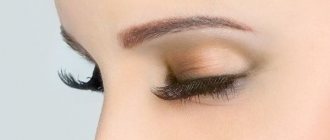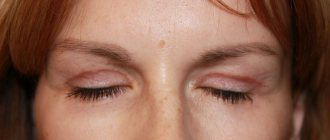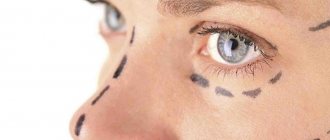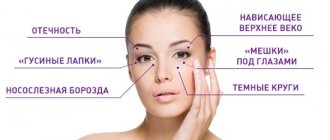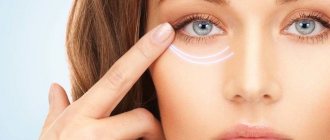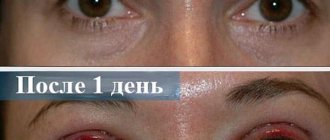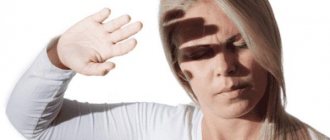Early difficulties
Blepharoplasty can cause serious complications after surgery
.
Let's take a closer look at each of these conditions and how you can cope with them.
Edema
Swelling of soft tissues is inherent in all surgical interventions without exception, which involve damage to the integrity of soft tissues.
When the patient has edema (in the affected area of the skin), vascular permeability increases, which leads to swelling.
This condition is considered normal after this operation. It lasts from two to seven days. Swelling can also cause blurred vision and headaches.
In order to get rid of them, you need to use anti-inflammatory ointments and gels, which will be prescribed by your doctor.
Hematoma
A hematoma can develop in the first hours after surgery or several days after it is performed.
There are three types of hematomas:
- subcutaneous
- characterized by the accumulation of ichor just under the top layer of skin due to impaired vascular function. It is eliminated using a catheter, which is inserted under the skin and pumps out excess fluid; - tense
– accompanied by profuse subcutaneous bleeding. It must be urgently eliminated by restoring the affected vessel; - retrobulbar
is the most dangerous hematoma that can develop due to damage to a large vessel. In this case, patients will experience an accumulation of blood under the eyeball. This can lead to blurred vision and pain. Such a hematoma is removed surgically.
Diplopia
Its symptoms appear almost immediately after the operation.
Most often, with diplopia, the work of the oblique muscle of the eye is disrupted. As a rule, this condition goes away on its own after 1-2 months.
Bleeding
Bleeding is the most common complication observed after blepharoplasty. It can also occur during the operation itself.
The danger with this condition is that the patient may lose too much blood, requiring additional plasma or blood transfusions. This in turn threatens blood poisoning.
Eversion of the lower eyelid
Because this operation can remove so much skin, patients sometimes experience lower eyelid inversion after the procedure. At the same time, the eye itself cannot close completely, which leads to its dryness.
In order to eliminate this condition, it is necessary:
- perform additional surgery;
- do a special massage for the eye to maintain and stretch muscle tone.
Infection of postoperative wounds
If sterility is violated during this surgical procedure, the patient runs the risk of infection in the wound.
This condition manifests itself in the form of an inflammatory process, high temperature and discharge of pus from the sutures.
Also, if an infection gets into the wound, the latter will take much longer to heal.
Orbital hemorrhage
Orbital hemorrhage is considered the most terrible consequence of blepharoplasty, as it threatens complete loss of vision.
This complication can result from a surgeon’s mistake or performing surgery on a patient with the following contraindications:
- hypertension;
- taking anticoagulants or alcoholic beverages before surgery;
- carrying out a long and complex operation.
This condition usually manifests itself within the first day after eyelid correction. It is very difficult to treat.
The most effective therapy is repeated surgery, but in severe cases there is no guarantee that lost vision will be restored.
Types and causes of extropion
In 90 cases out of 100, lower eyelid inversion is diagnosed. In this case, a number of characteristic symptoms are always detected:
- Increased lacrimation, very often non-stop.
- Redness of the eyelids and conjunctiva due to constant rubbing of the eye.
- Sensation of a foreign body or sand in the eye.
- Incomplete closure of eyelids.
There are several types of extropion, each of them has its own ways of occurrence. Often the treatment method will depend on the cause of the inversion. Ophthalmologists use the following classification.
Atonic (involutional) extropion
Occurs most often. It is also called senile, as it occurs in older people. The appearance of atonic eversion of the eyelids is correlated with the natural aging of the body and a weakening of overall muscle tone. The result of involutionary processes is sagging of the skin, which provokes eversion.
With senile extropion, bilateral inversion may be observed, which increases with age. If left untreated, the cornea becomes thickened, followed by keratinization and possibly clouding, which leads to partial blindness.
Not only surgical methods are suitable for the treatment of atonic ectropion. At first, drug therapy may be used. However, this is a temporary measure and will not completely eliminate the problem.
You can get rid of atonic ectropion through surgery. During the manipulation, a part of the skin-cartilaginous tissue is excised horizontally, which restores the natural fit of the eyelid to the eyeball. The operation can be performed in many ways and always gives a good result.
Congenital ectropion
This form refers to a congenital pathology and occurs in the perinatal period, during fetal development. There may be several types of congenital pathology, depending on which structures of the eyelid are undeveloped, but the treatment is always the same - surgery.
If the sagging is minor and there are no significant symptoms, surgery is not performed.
Cicatricial extropion
Cicatricial eversion occurs after an injury, plastic surgery on the face and eyes, eyelids, and the skin around them (blepharoplasty). Moreover, eyelid inversion after blepharoplasty occurs after several weeks or months. This is due to the fact that the incisions will take some time to heal and as the sutures dissolve and the scar forms, extropion increases.
Pathology is observed from the side of scar formation.
It is very difficult to treat eyelid inversion after blepharoplasty; in such cases it always involves surgical intervention.
Paralytic type of disease
The paralytic form of extropion is usually part of an extensive paresis or paraparesis, which affects the muscles of other parts of the face: lips, cheeks, and sometimes lower and upper limbs.
In this case, inversion and eversion of the eyelids will be treated by a neurologist. After all, complex treatment of the underlying disease will be required.
Conservative (drug treatment) is used here; surgical methods are usually not resorted to.
Reasons for appearance
Complications after eyelid correction using plastic surgery can have different origins. The reasons are divided into several groups:
Failure to comply with the conditions of preparation for blepharoplasty and postoperative rehabilitation. Usually the patient is informed about what is permitted and prohibited during these periods. Ignoring the rules can cause most complications. For example, taking blood-thinning medications provokes bleeding, swelling, and makes healing difficult. So after this you can expect any problem. The same thing happens when the patient does not want to give up smoking, starts physical activity too early, does not take good care of the stitches, and refuses procedures aimed at accelerating recovery. Even dietary disturbances, which should be light after blepharoplasty, can cause complications.
Features of the patient's body. To a greater extent, this relates to the process of scar formation. If blepharoplasty is the first procedure performed, the tendency to form hypertrophied and keloid scars on the eyelids may be an unpleasant surprise.
Consultation with a specialist:
Upper eyelid surgery is performed in much the same way. Holders are applied, the scars are removed, and a wound is formed. Then the upper eyelid is sutured to the cheekbone area. We collect skin from the inner surface of the shoulder and also stitch it up. The sutures are removed on the 7th day. If there was deformation of both the upper and lower eyelids, then usually one eyelid is done, and the other after 2-4 months.
Corr:
We looked at post-burn eyelid eversion. Let's talk about other cases.
Such correction can be attributed to both post-burn and post-traumatic deformities.
Corr:
What if a patient comes up with such a problem after undergoing blepharoplasty?
Such cases are rare. But if this has happened, and after the operation a cicatricial eversion of the eyelid appears, it needs to be eliminated. If this is discovered immediately after surgery, then we simply fix the lower eyelid in a state of hypercorrection, for example, with an adhesive plaster. As a rule, this only happens on the lower eyelid. The patient walks in this state for some time, and the inversion gradually disappears.
Corr:
What if a lot of time has passed since the operation?
Such cases are extremely rare. The correction is standard, as with post-burn deformities - a graft is transplanted. In general, patients who have inverted eyelids after blepharoplasty are prone to keloidosis. With such individual characteristics, the patient, before going for blepharoplasty, needs to look at: if there have been operations before, how postoperative scars behave. If there are keloid scars, then such patients should be treated with more caution.
Corr:
Let's now consider a general case. Let's say there is an injury to the eyelids. Should she be treated as quickly as possible?
In general, in the treatment of post-burn deformities there is an unspoken rule: if the patient has suffered burns, then it is most convenient to perform reconstructive operations a year later. The scars must mature. At the initial stage, when they are bright red in color, accompanied by itching and pain, the patient is treated with physiotherapy.
But in case of damage to the eyelids, they deviate slightly from this rule. Eyelids can be operated on earlier. For example, several months after the injury. The fact is that an open eyelid is a constant source of irritation. If the eye is open all the time, keratoses and diseases of the eye mucosa occur. Therefore, it is better not to delay treatment and have surgery early.
Natalia Alekseevna, thank you for your story! Cicatricial deformities are always unpleasant, and in the case of eyelids, it is also a matter of preserving vision. Therefore, we hope that a detailed discussion of this topic will be useful to our patients.
Diagnostic measures
The patient can recognize eyelid inversion independently. During the examination, the doctor confirms the diagnosis, determines the symptoms of complications, and establishes the cause.
The following signs help the doctor determine the type of pathology:
- the presence of a scar indicates the development of cicatricial ectropion. In this case, the eyelid can be easily given a physiological position by pulling the skin to the side;
- during the examination, the doctor may notice the appearance of neoplasms, which indicates the development of mechanical eversion;
- reduced sensitivity or its absence indicates the development of paralytic ectropion.
What to do if a medical error occurs
If, after blepharoplasty, in the patient’s opinion, a medical error occurred, then this fact must be documented. For this:
- You will need to undergo examination and examination at an independent clinic specializing in eyelid surgery.
- Collect original documents certified by the seals of the clinic where the blepharoplasty was performed.
- Provide supporting documentation of the operation being performed by a specific surgeon.
- The original contract with the clinic for eyelid correction in the clinic.
It is almost impossible to independently prove the presence of a medical error after plastic surgery. Therefore, in this case, you will need the help of a qualified lawyer. If you have the originals of all documents confirming that blepharoplasty was performed in the blade, the percentage of positive outcomes in litigation increases.
What can a patient claim?
If the procedural case regarding medical errors after unsuccessful blepharoplasty is carried out correctly, the patient can claim:
- Repeated blepharoplasty.
- Correction of negative consequences, both physiological and aesthetic.
- Completion of a rehabilitation course.
- Compensation for moral and material damage.
- Termination of the surgeon's medical practice and deprivation of the clinic's license to perform plastic surgery.
Don't be afraid to seek the help of lawyers. Often such cases end in favor of the patient. The clinic or doctor provides complete recovery after surgery, maintaining its positive reputation.
Complications during blepharoplasty and methods for their correction
Lipofilling of the upper eyelid in order to recreate the mendala shape of the eye lost after blepharoplasty.
An unsuccessful surgical intervention can lead to dissatisfaction with the client with the aesthetic results obtained or cause complications of blepharoplasty of varying severity. The problems that arise after unsuccessful lower and upper blepharoplasty differ radically.
Complications after upper eyelid blepharoplasty
When performing upper eyelid surgery, the surgeon makes an incision at the level of the skin fold of the upper eyelid. As a result, the scar tissue hidden in the fold remains invisible to the eyes of others. The operation involves excision of excess fat on the upper eyelid, straightening and removal of fatty hernias. Among the most common complications of upper eyelid blepharoplasty, experts note:
- Excessive excision of skin. In most patients, the skin stretches spontaneously after a short period of time. If this does not happen, then the patient is prescribed injections of a special drug that provokes stretching;
- Insufficient skin excision. In this case, there is no way to do without a repeat operation to remove excess skin tissue;
- Excessive removal of fatty tissue (so-called fatty hernias). The error entails a complication in the form of skeletonization of the upper eyelids. The deficiency can be corrected using the lipofilling method.
Complications after lower eyelid blepharoplasty
A complication in this case is excessive removal of fatty tissue (hernias) during the first blepharoplasty.
Ptosis (the lower eyelid is excessively taut downwards). This complication of lower eyelid blepharoplasty occurs due to excessive removal of skin under the eyes. The correction can be carried out in two ways. The surgical method involves performing canthopexy (its goal is to strengthen the outer edges of the lower eyelids). To improve the aesthetic effect, our specialists usually complement this operation with lipofilling of the outer corners of the eyes, which creates a supportive cushion. The second method is medicinal, when the skin is stretched using special drugs. Elimination of the defect with medications can only be used 6 months after unsuccessful blepharoplasty.
Possible
This category of complications after blepharoplasty, which do not always occur, but only when the postoperative and rehabilitation period is improperly managed:
- infection is a consequence of bacteria entering a postoperative wound, manifested by inflammatory processes with the possible formation of pus, this complication develops when the rules of antiseptics and asepsis are not observed during or after surgery, treatment consists of prescribing antibiotics (ceftriaxone) and washing the eyes and eyelids with antiseptic solutions (furatsilin , chlorhexedine);
- ectropion – inversion of the lower eyelids after blepharoplasty, which leads to their incomplete closure, increased dryness and keratosis of the sclera of the eyeball, treatment is only surgical, consisting of plastic surgery of the tissues and muscles of the lower eyelid;
- diplopia – double vision, caused by damage to the muscles of the eyeball after surgery, treatment consists of mandatory surgical plastic surgery of the damaged muscles with restoration of their integrity;
- Deterioration of vision is a serious complication that has many causes in its occurrence, namely a tense hematoma, leading to a deterioration in the nutrition of the retina, dry keratoconjunctivitis, which can cause the formation of an eyesore; all these causes require immediate adequate treatment.
Laser blepharoplasty allows you to minimize late and possible complications, due to the virtual absence of significant trauma to the skin and subcutaneous tissue of the eyelids.
Early complications of blepharoplasty are minimal; with proper management of the postoperative period, they resolve on their own and do not require special treatment.
These recommendations include:
- avoiding taking medications that reduce blood clotting (aspirin, acetylsalicylic acid);
- avoiding physical activity after surgery;
- a cold compress on the eyelids to prevent and reduce tissue swelling;
- You cannot use makeup after surgery;
- using special eye drops or artificial tears to prevent keratoconjunctivitis sicca;
- the use of antiseptic solutions or ointments for the eyelids will eliminate infectious complications;
- avoiding excessive insolation (exposure to sunlight) on postoperative wounds will make it possible to prevent most complications of blepharoplasty;
- the effect of high temperatures on the skin of the eyelids after surgery can increase swelling, inflammation, and provoke late bleeding, so you should avoid visiting a bathhouse or sauna.
Symptoms of eyelid inversion
One of the most characteristic symptoms of ectropion is increased lacrimation (the medical term is “epiphora”). Normally, the tear fluid produced by special glands (and also, partly, by the lacrimal glands of the conjunctiva) serves to cleanse small particles, moisturize and lubricate the outer surface of the eye, primarily the cornea, which prevents it from drying out when exposed to oxygen in the air. Removal and drainage of used tear fluid is carried out through special tubules located on the conjunctiva (i.e. on the inner surfaces of the eyelids) - the so-called. "tear points" Almost the entire volume of lacrimal substance is thus excreted through a special duct into the nasal mucosa - in other words, it enters the nose.
But with ectropion, when the above-described drainage tract is grossly destroyed, the lacrimal fluid cannot naturally enter the lacrimal openings. Accumulating in the gap formed between the eye and the eyelid, at a certain volume it begins to overflow.
It should be emphasized that with the gradual formation of the organs of vision, evolution “had” to solve two opposing problems: drying out and souring of tissues due to constant excessive wetting. That is why the composition of tears is balanced in such a way that it contains not only purely liquid, moisturizing components, but also a certain mucous “lubricant” that maintains the moisture balance necessary for the outer eye membranes. With eversion of the eyelid, such balance is impossible; the lower part of the cornea and sclera dries out without the constant washing movement of the blinking eyelid, the lacrimal glands try to compensate for this and reflexively increase the secretion of fluid.
The inverted conjunctiva and the outer skin of the eyelid, on the contrary, are constantly in a stream of flowing tears, and in a heterogeneous stream: some areas dry out, others get wet. The result is a feeling of discomfort, itching, a foreign body (the most eye-specific reactions to any problem), as well as a corresponding urge, sometimes irresistible or realized unconsciously, to rub the eye. As a result, the dermis and mucous membrane of the lower eyelid quickly become inflamed.
Externally, this is manifested by redness, swelling, and the characteristic appearance of “sick meat.” Obviously, under such conditions, a direct path opens for the penetration of all kinds of pathogenic microorganisms (viruses, bacteria, fungi, parasites). With such an invasion, the pathology easily acquires an acute purulent character and can spread to adjacent ocular tissues, sometimes leading to very serious complications and consequences, including panophthalmitis (total inflammation of the eyeball) and the initiation of atrophic processes in the retina and optic nerve, resulting in blindness.
How to detect an eversion of the eyelid?
Typically, diagnosing extropion is not difficult: the defect can be seen by the patient himself in the mirror.
When visiting a doctor, an ophthalmologist performs standard examinations:
- External examination, which allows us to determine the presence of decreased tone of the periorbital muscle, the degree of atony, swelling of the skin, the degree of non-closure of the eyelid (lagophthalmos), the presence of tumors or scars.
- Biomicroscopy will help to examine the conjunctiva, the edges of the eyelid in more detail, and assess the size of the pathology in more detail.
- Visometry and perimetry. These studies will evaluate the impact of eversion on quality of vision.
- Computer keratometry to clarify the diagnosis.
- A series of laboratory tests on eyelid scrapings and some blood tests.
After the examination, a form of treatment for eyelid inversion is selected.
Advice. Seek advice from an ophthalmology clinic that performs ophthalmological surgeries. This way, you won’t have to do the same examinations twice.
Definition of disease
Eversion of the eyelid is divided into several types, depending on the etiology. More precise symptoms are also associated with the species, on the basis of which the doctor makes a diagnosis:
- Congenital ectropion. This type of disease is autosomal hereditary and rarely occurs on its own (for example, the pathology is often associated with ptosis, epicanthus inversus, or blepharophimosis). Disappears spontaneously as the face grows. Relatively often affects the upper eyelids. The therapy consists of suturing the lateral edges of the eyelids and moving or transferring the skin.
- Involutional (atonic) eversion of the eyelid. It is the most common form of the disease. It is especially common in the lower eyelid in elderly patients, in whom the problem is caused by weakening of the tissue and paralysis of the pretarsal part of the orbicularis oculi muscle. The disease is accompanied by significant lacrimation, hyperemia and hypertrophy of the conjunctiva. The therapy consists of horizontal shortening of the eyelid at the site of the temporal (motor) edge, as a result of which re-adhesion (sufficient adherence) of the eyelid to the eyeball is achieved.
- Paralytic ectropion. As a result of reduced function of the circular eye muscle (m. orbicularis oculi), a person cannot completely close the eyelids, which often causes the development of lagophthalmos. The cause is often considered to be paresis of the facial nerve n.VII. Therapeutic methods include suturing the edges of the eyelid, that is, tarsography.
- Cicatricial ectropion. Occurs, in particular, as a result of tension caused by scars on the skin of the eyelids and around them (often these are formed as a result of burns, including chemical burns, trauma or cancer of the eyelids). The treatment is quite complex: Z-plasty is performed on the site of traction scars. In the case of extensive processes, the cords are excised and the skin is covered plastically from the second eyelid or from the mastoid area (processus mastoideus).
Eversion of the eyelid (another name for ectropion) by definition is a persistent defect characterized by a change in position (lag) of the ciliary edge directly from the eyeball. This is accompanied by exposure of the conjunctiva of the eye.
The mechanism of action of the disease lies in the cartilage that supports the eyelid. It is he who, under the influence of certain reasons, can turn out together with the eyelid itself. Eversion of the lower eyelid is more common; pathology of the upper eyelid is extremely rare and is usually associated with the anatomy of the eye.
Types of eyelid eversion
According to the etiological (cause-and-effect) criterion, ectropion is classified into the following categories:
- senile (caused by age-related degradation of muscle and skin tissues, their stretching; pathology usually develops symmetrically in both eyes and, in the absence of adequate treatment, steadily progresses with age);
- scar (forms as fibrous tissue grows after burns, ulcerative inflammation, trauma, etc.; since scar tissue is much larger than functional tissue, the contact of the conjunctiva with the eye is mechanically disrupted - the eyelid simply “moves away” from the eyeball, gaps appear, and lacrimal secretion increases fluids, etc. The dynamics and clinical picture of cicatricial ectropion largely depend on the localization of primary scarring);
- paralytic (due to neuropathology and functional failure of the facial nerve, which controls the entire facial muscular system - from facial muscles to the motor system of the eyelid);
- mechanical (occurs as a result of the progression of various oncopathologies; as in the case of cicatricial ectropion, as the tumor grows, mechanical contact with the eyeball is disrupted. In addition, cellular degeneration distorts the system of forces and mechanical stresses in the eyelid itself, as a result of which the resultant of these forces begins to increase pulls the conjunctiva away from the eye - instead of pressing it against it - and eventually turns the eyelid outward).
Useful tips
- physiotherapy;
- microcurrents;
- laser resurfacing;
- eye exercises;
- massage;
- mesotherapy;
- medicinal and cosmetic preparations.
As a rule, they are used after the rehabilitation period (after 2 weeks) to speed up the healing process.
Microcurrents
Microcurrents after blepharoplasty help rapid recovery. After the procedure, the following processes occur:
- relieves inflammation and fatigue;
- excess fluid is removed and swelling on the eyelids is reduced;
- lymph outflow improves;
- wound healing accelerates;
- muscles relax and recover.
Microcurrent therapy is also used to prevent the formation of keloid scars after blepharoplasty.
Mesotherapy
Stimulates metabolic processes, improves blood circulation and promotes cell restoration. During the procedure, injections with medicinal preparations are injected under the skin in the eyelid area, which contain amino acids, vitamins, herbal components and other beneficial substances.
Laser resurfacing
During the procedure, the desired areas are exposed to a carbon dioxide laser and the upper stratum corneum of the skin is cleaned. The session lasts 30–60 minutes.
After laser exposure, a slight burning sensation and peeling on the eyelids may occur, which will subside within 10 days. Laser resurfacing is prescribed no earlier than 2 months after eyelid blepharoplasty.
Drugs
They are used for the eyes after surgery, when it is necessary to relieve inflammation, restore dermal receptors, strengthen blood vessels, prevent the formation of blood clots and improve the general condition of the eyelids.
Popular means:
Lyoton - will help get rid of swelling, remove bruises, inflammation, relieve pain;
Lokoid - relieves swelling and inflammation, disinfects;
Dermatix is used to strengthen capillaries, eliminate pigmentation and soften scar tissue;
Troxevasin will also help remove bruises and swelling from the eyelids;
The drugs Kelo-lot and Contractubex work well for smoothing scars after blepharoplasty.
Among the cosmetics and folk remedies that help alleviate the condition of the eyelids during the rehabilitation period, the following can be used:
- gels with caffeine, retinol, Chinese mushroom extract;
- decoctions of chamomile, sage, juice of parsley leaves, linden, which are used as compresses for eyelids.
Eye drops
Prescribed in the first two to three days after blepharoplasty to prevent drying out and infection in the eyelid area, since the eyes are still slightly open. This could be Levomycetin or Albucid. They need to be instilled every 3-4 hours, two drops. If plastic surgery of the lower eyelids was performed, Solcoseryl gel is placed into their inner surface (conjunctiva) overnight.
Gymnastics
Regardless of whether blepharoplasty of the upper or lower eyelids was performed, special gymnastics are prescribed during the rehabilitation period. It helps tone muscles, increase blood circulation and restore eye functionality.
It is better to do it twice a day: morning and evening.
Basic exercises:
- Focus your gaze on a point above, below, left and right.
- Raise your face up and blink continuously for 30 seconds.
- Close your eyes, then open your eyes and immediately focus your gaze on a distant point in front of you.
- Place your index fingers on your temples and lightly pull the skin to the sides. The eyes are closed.
- Close your eyes and cover your eyelids with your index fingers. Without lifting your fingers (without pressure), look up.
- Tilt your head back and focus your gaze on the tip of your nose. Relax.
Each exercise should be repeated 5-7 times, with the exception of the second.
Lymphatic drainage massage
To avoid complications associated with blepharoplasty, your doctor may recommend massage. The procedure helps improve blood circulation, remove toxins and improve the functioning of lymph flows. Each movement must be performed 10 times, pressing your fingers pointwise clockwise in the following places:
- on the temples;
- from the outer edge of the lower eyelid to the inner;
- on the wings of the nose;
- moving along the upper eyelid, press from the inside of the eye to the temple.
Any physical procedures and other therapy after blepharoplasty help to recover faster. But they also have contraindications and side effects. Therefore, you should talk to your doctor about the advisability of their use.
The cost of repeated blepharoplasty at the Doctor Grishkyan plastic surgery clinic in Moscow.
Blepharoplasty (eyelid surgery) cost of surgery
| Operation name | Cost in rubles |
| Volumetric plastic surgery of the upper eyelids | 180000 |
| Volumetric lower eyelid surgery | 180000 |
| Blepharoplasty of the upper and lower eyelids | 250000 |
| Transconjunctival blepharoplasty of the lower eyelids (author's technique) | 180000 |
| Repeated blepharoplasty of the upper eyelids, correction of complications after eyelid surgery by another surgeon | FROM: 210 000 |
| Repeated lower eyelid blepharoplasty, correction of complications after eyelid surgery by another surgeon | FROM: 210 000 |
Contraindications
There is a list of indications for which blepharoplasty should be avoided:
- problems with blood clotting;
- suffered a heart attack or stroke;
- complex stages of diabetes mellitus;
- blood pressure problems;
- retinal detachment;
- tumor neoplasms;
- kidney and liver diseases;
- period of critical days;
- pregnancy or lactation;
- diseases associated with inflammation of the eyelids;
- infectious diseases;
- inflammation of the tear ducts;
- conjunctivitis.
Failure to comply with contraindications can lead to irreversible consequences.
Blepharoplasty is completely contraindicated in the following cases:
- For hypertension
- Endocrine disorders, incl. hypo- and hyperthyroidism
- Serious diseases of the heart and blood vessels
- Kidney failure
- For diabetes
- For diagnosed eye diseases: glaucoma, xerophthalmia, retinal detachment
You should not have blepharoplasty if less than a year has passed since the previous intervention, or if you have recently undergone a serious illness or major surgery.
This operation is indicated for people in the following cases:
- Having bags under the eyes.
- Presence of wen under the eyes.
- Severe wrinkles on the lower eyelid.
- Sagging of the upper eyelid.
- Having a “heavy” look.
- The presence of various birth defects or pathologies of the eyelid.
- Acquired (after injury, surgery or burn) eyelid defects.
- Drooping of the corners of the eyes.
- Excess flesh on the lower eyelids.
Before agreeing to this operation, you must remember the following contraindications to its implementation:
- diabetes mellitus type 1 and 2;
- the presence of an inflammatory process in the body, which is accompanied by high temperature;
- acute or chronic respiratory diseases;
- hepatitis;
- severe infectious diseases;
- presence of oncological pathologies;
- pregnancy and breastfeeding;
- the patient's age is up to eighteen years;
- dry eye syndrome;
- blood clotting disorder;
- acute diseases of internal organs;
- hypertension;
- increased intracranial pressure;
- dysfunction of the thyroid gland;
- infectious diseases of the eyes or nose.
Contraindications include any acute infectious and inflammatory diseases, as well as chronic ailments at the acute stage (in such cases it is better to undergo the necessary course of therapy and wait for recovery).
The operation is not performed during menstruation.
Xerosis of the eyes (dry mucous membrane) is also a limitation to therapy.
The procedure is not performed if the patient has high blood or intraocular pressure.
Contraindications include systemic blood diseases, as well as blood clotting disorders (high risk of bleeding).
Contraindications also include cancer, diabetes and hormonal imbalances (especially when it comes to thyroid diseases).
This is why it is important to undergo a full examination before scheduling surgery.
What causes lower eyelid inversion?
The causes of ectropion of the eyelids are usually associated with previous diseases or surgery, since ectropion of the eyelids often acts as a side effect after various problematic situations.
- The main causes of ectropion of the lower eyelids:
- Age-related changes in subcutaneous fat;
- Cicatricial deformation of tissue due to injury;
- Paralysis of the facial nerve or cerebral circulatory disorders, which reduces muscle tone;
- Unsuccessful eyelid surgery;
- Inflammatory processes in the eye area.
Getting rid of ectropion after blepharoplasty with surgery
There are two options for correcting this problem - conservative and surgical. In the first situation, massage and gymnastics are used to increase the tone of the orbicularis oculi muscle. Depending on the type of pathology, the age of the patient, and the condition of the facial tissues, different surgical techniques can be used. To select them, the doctor relies on the following factors:
- why did the inversion appear;
- what is the condition of the soft tissues in the eyelid area: excess or deficiency;
- the degree of weakness of the ligaments that fix the corners of the eye in a particular state;
- presence of scars and other skin damage.
The general essence of surgery is to move the injured musculocutaneous structure of the eyelid to the correct position and secure it. This can only be done by a plastic surgeon or an ophthalmologist in a special department. The preparatory stage begins with a meeting with the surgeon, after which the patient will need to undergo tests. The list of studies is as follows:
- general blood and urine tests;
- platelet count test;
- blood chemistry;
- electrocardiogram;
- fluorography.
Depending on age and health status, additional studies and consultations with specialists may be indicated. If the intervention will be performed under general anesthesia, it is additionally necessary to consult with an anesthesiologist. The operation itself lasts from 1 to 3 hours, it all depends on the chosen technique and the complexity of the problem.
The access incisions are located in natural skin folds and are sutured with a special cosmetic suture, so the scars will not be visible in the future.
The first day after surgery, the patient remains in the clinic under the supervision of a doctor. After discharge, you need to regularly visit the doctor to monitor tissue tightening and evaluate the result of the intervention. During the first two weeks, there will be swelling and bruising around the eyelids and middle third of the face. In the first hours and days after the intervention, swelling may increase. \
We recommend: Rules for treating chemosis with drugs after blepharoplasty
To stop this, you need to use cold compresses. For rapid tissue regeneration and resorption of swelling, it is necessary to perform physiotherapeutic measures. To prevent the occurrence of rough scars, proteolytic substances can be administered.
Contraindications, possible complications, side symptoms
The surgeon will not perform the operation in the following situations:
- diabetes;
- high blood pressure with constant sudden crises;
- severe heart and vascular diseases;
- diseases of the thyroid gland, which are accompanied by hormonal imbalance;
- dry eye syndrome;
- retinal detachment.
The most negative consequence of the intervention is that the defect often cannot be corrected 100%. A small distance between the edge of the eyelid and the eyeball may remain. There is also a risk of the eyelid turning inwards. Other possible complications include:
- bleeding wounds in the first days or after surgery;
- seam divergence;
- wound infection, the appearance of an inflammatory process;
- the appearance of rough scars in the eyelid area;
- the appearance of skin cysts;
- malfunction of the lacrimal glands;
- the appearance of blepharoptosis and lagophthalmos.
Repeat surgery will be required to correct many of these complications. The risk of their occurrence can be minimized if you adhere to the main rules during rehabilitation:
- refuse to go to baths, saunas, swimming pools - this way, swelling and hematomas will not increase in the first 14 days after the intervention;
- protect postoperative scars from exposure to direct sunlight for 6 months after surgery. This will be an ideal prevention of the formation of age spots;
- limit physical activity, refuse to perform work in an inclined position for 30 days after the intervention - this way, the tissues will heal quickly and the swelling will go away.
The main thing is not only the operation, but also postoperative rehabilitation, during which the patient must follow all the doctor’s recommendations so that no complications arise and the result does not keep you waiting long.
YouTube responded with an error: Daily Limit Exceeded. The quota will be reset at midnight Pacific Time (PT). You may monitor your quota usage and adjust limits in the API Console: https://console.developers.google.com/apis/api/youtube.googleapis.com/quotas?project=268921522881
Treatment of ectropion
Etiopathogenetic, – i.e. aimed at eliminating the causes of the disease, therapy for ectropion varies depending on its specific variant. However, almost always, eversion of the eyelid requires some kind of surgical intervention (blepharoplasty), since it is impossible to restore the anatomical and mechanical structure of the tissues with medication.
Thus, senile ectropion requires restoration of the natural contact of the inner surface of the eyelid with the eye by tightening (reducing in volume) stretched skin that has lost strength and elasticity. One of the key tasks is to restore natural blinking function with complete closure of the eyelids.
Cicatricial ectropion is eliminated in a similar way: scar tissue is surgically removed, and the natural geometry and mechanics of the eyelid are restored.
Ectropion of the mechanical type requires, first of all, the intervention of oncologists and/or dermatologists: removal of the tumor, biopsy and prevention of relapses come to the fore. After this, if necessary and according to indications, a repeat reconstructive operation may be prescribed to reconstruct normal fit and closure.
Learn more about blepharoplasty surgery >>>
Only with paralytic ectropion, the role of the ophthalmologist is, in fact, limited to palliative, purely symptomatic treatment. Etiopagenetic therapy here is to eliminate the causes of nervous paralysis - as far as possible in each case - and such treatment should, of course, be carried out by a neurologist. As the conductive activity of the facial nerve is restored, the functions it regulates are gradually restored, in particular, the position, tone and mobility of the eyelid.
To eliminate subjective discomfort, for the prevention and treatment of an infectious component (if one has already been introduced), for any type of ectropion, anti-inflammatory, antibiotic, immunostimulating drugs in various pharmaceutical forms, as well as eye moisturizing drops (artificial tears) can be prescribed. However, the appropriateness, form, frequency, and dosage of any medications must be determined by a doctor; self-medication is contraindicated in all cases.
Symptoms and Classification of ptosis and the occurrence of ptosis of the upper eyelid
The main symptoms are:
- visually noticeable blepharoptosis;
- sleepy facial expression (with bilateral lesions);
- formation of forehead skin wrinkles and slight eyebrow lifting when trying to compensate for ptosis;
- rapid onset of eye fatigue, a feeling of discomfort and pain when straining the organs of vision, excessive tearing;
- the need to make an effort to close the eyes;
- over time or immediately occurring strabismus, decreased visual acuity and double vision;
- “Stargazer pose” (slightly throwing the head back), especially characteristic of children and being an adaptive reaction aimed at improving vision.
The mechanism of development of these symptoms and ptosis itself is as follows. The motor functioning of the eyelid and the width of the palpebral fissure depend on the tone and contractions:
- The levator of the upper eyelid (lifting muscle), which controls the vertical position of the latter;
- The orbicularis oculi muscle, which allows you to close the eye steadily and quickly;
- The frontalis muscle, which promotes contraction and compression of the eyelid with maximum upward gaze.
Tone and contraction are carried out under the influence of nerve impulses arriving to the circular and frontal muscles from the facial nerve. Its nucleus is located in the brainstem on the corresponding side.
The levator palpebrae superioris muscle is innervated by a group of neurons (right and left bundles of the central caudal nucleus), which are part of the nucleus of the oculomotor nerve, also located in the brain. They are directed to the muscles of their own and the opposite side.
Main consequences after blepharoplasty
| Consequence | What to do? | Is repeat surgery necessary? | Can it go away on its own? |
| Swelling | – cold compresses; – decongestants; – correct sleeping position (head slightly elevated) | No | Yes |
| Subcutaneous hematoma | – surgically (open the wound and remove blood); - suturing the damaged vessel | yes, if a large vessel is damaged | Yes |
| Retrobulbar hematoma | – control by an ophthalmologist; – decongestants | in rare cases | Yes |
| Seam divergence | – re-stitching | new stitches need to be placed | No |
| Keratoconjunctivitis and dry mucous membranes | - eye drops; – artificial tear; – antibacterial therapy | No | Yes |
| Tearing | – decongestants; – installation of a probe that expands the lacrimal canal | No | Yes |
| Diplopia | – control by an ophthalmologist | No | Yes |
| Incomplete closure of eyelids | - eye drops; – artificial tear | No | Yes |
| Blepharoptosis | – light massage; – surgeon control; - operation | Yes | |
| Eversion of the century | – light massage; – supporting seams; - operation | yes, if not for a long time | Yes |
| Asymmetry of the eyelids | – surgeon control; - operation | yes, with strong asymmetry | yes, in mild cases |
| Cysts | – surgeon control; – opening and removal | yes, if not for a long time | Yes |
| Keloids and scars | – ointments with absorbable action; – laser therapy; – mesotherapy, etc. | No | Yes |
| Infectious lesions | – antibacterial therapy; - operation | yes, if antibiotics don't help | No |
Eversion of the lower eyelid after blepharoplasty
As a rule, lower eyelid inversion after surgery occurs due to excessive excision of skin. The eyelid begins to deform and turn down, which, in turn, leads to constant dryness of the eye and inflammatory processes in the future.
As a rule, there are two ways to treat such a complication: conservative and surgical.
In the first case, various eye exercises and massage are used - this helps to increase muscle tone, and it can rise on its own. Special support sutures can also be used, which can have a positive effect if used for a long time.
If such methods do not provide the desired result, then inversion of the lower eyelid after blepharoplasty can be corrected using repeated surgical correction.
It is worth noting that lower eyelid inversion after blepharoplasty is very often the result of incompetent work by a plastic surgeon, which is why it is very important to take the choice of a specialist seriously.
A plastic surgeon must have extensive and continuous experience; it is in this case that he is a truly competent specialist in his field and will be able to flawlessly perform any operation.
Therefore, if you want to have primary or revision blepharoplasty, you should not rush, consult various specialists to choose someone who will inspire your trust. The moment of trust between the doctor and the patient is a very important factor in any operation and in many ways the key to its success!
We invite you to a free consultation with plastic surgeons at our clinic - experienced specialists will select an individual solution to your eyelid inversion problem and help restore the beauty of your eyes.
Prevention of ectropion of the eyelid
There is no specific prevention to reduce the primary risk of ectropion of the eyelid. According to practicing specialists in the field of ophthalmology, a medical examination (once a year) will be sufficient. Early diagnosis followed by prescription of drug therapy will avoid surgical intervention. In order to prevent relapse of the pathology, the patient must adhere to the following rules and recommendations:
- perform daily hygienic care of the visual organs;
- when diagnosing infectious eye diseases, provide timely treatment, preventing the pathological condition from becoming chronic;
- minimize possible injuries to the eyeball;
- in the postoperative period, temporarily refrain from visiting the gym and swimming pool (limit physical activity to a minimum);
- impose a complete taboo on the consumption of alcohol and smoking;
- in sunny weather, use special cosmetics to protect against ultraviolet radiation or wear sunglasses.
Patients who have been diagnosed with ectropion of the eye need to know that the disease does not go away on its own. In some cases, even drug therapy does not have the desired effect
Particular care should be taken when using traditional healing methods, since they cannot prevent the pathological process, and superficial elimination of negative symptoms provokes the transition of the disease to an advanced form.
